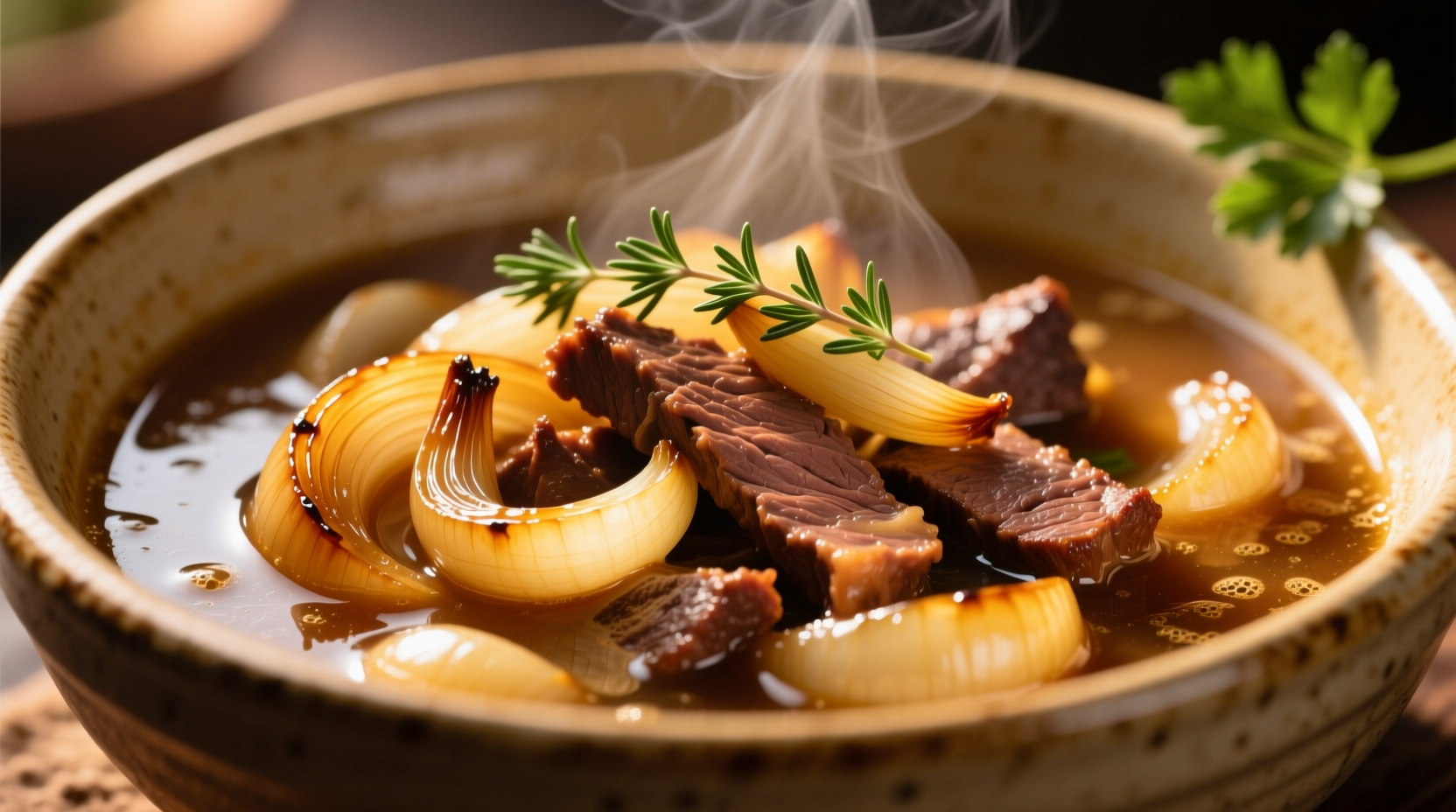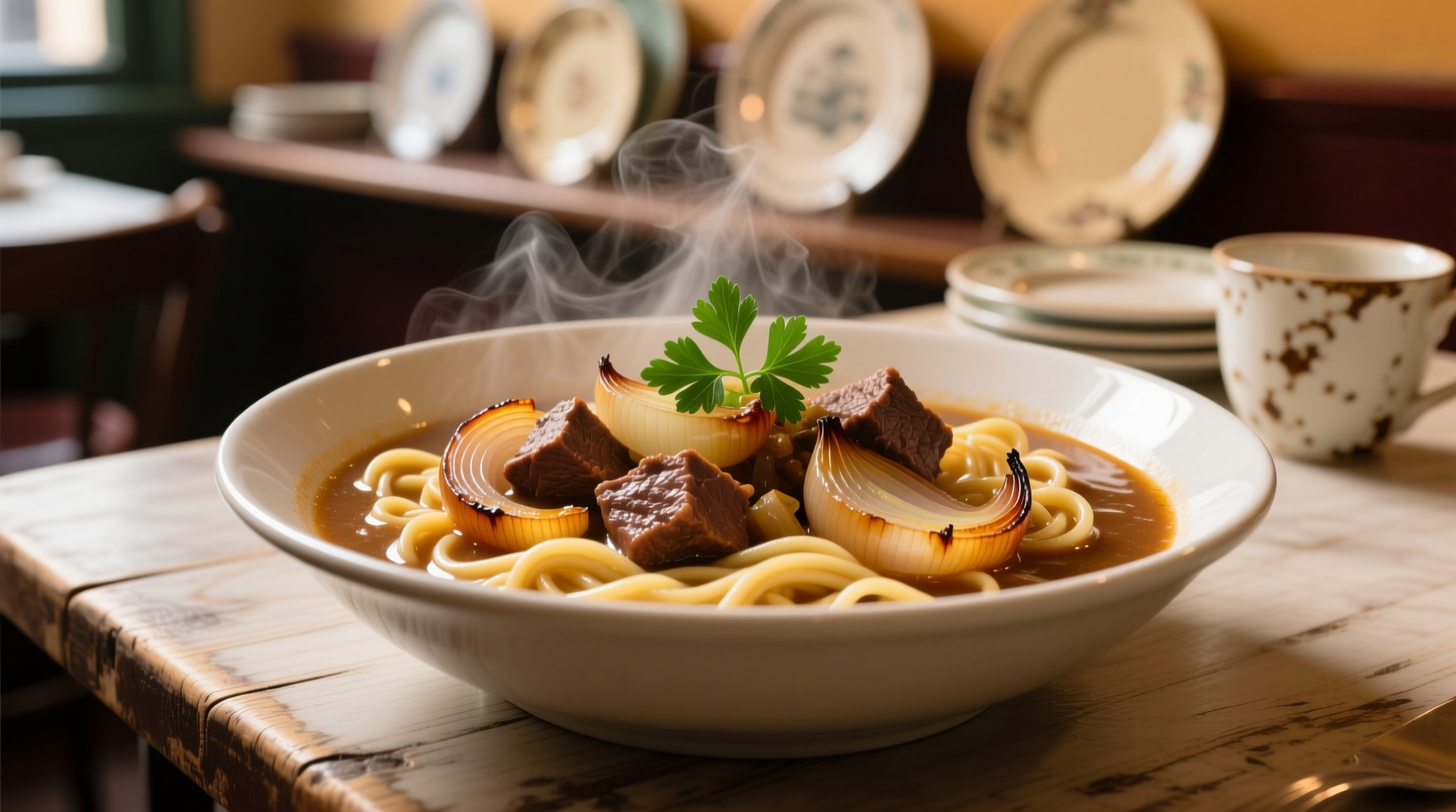Understanding This Comfort Food Fusion
French onion beef and noodles represents a brilliant culinary crossover that marries the deep umami flavors of traditional French onion soup with the satisfying heartiness of Asian-inspired noodle dishes. While not a classic French bistro offering, this modern fusion has gained popularity in American home kitchens for its perfect balance of sophistication and comfort.
Unlike traditional French onion soup served with baguette and melted cheese, this adaptation incorporates tender beef strips and egg noodles, creating a more substantial meal that satisfies multiple cravings simultaneously. The dish works particularly well during colder months when rich, warming foods are most appreciated.
Essential Components Explained
The magic of French onion beef and noodles happens through three critical elements working in harmony. Understanding each component ensures your dish achieves that perfect balance of sweet, savory, and satisfying textures.
| Component | Key Characteristics | Common Mistakes to Avoid |
|---|---|---|
| French Onion Base | Deep golden-brown caramelization, sweet-savory balance | Rushing caramelization, high heat causing burning |
| Beef Selection | Tender cuts that maintain texture when simmered | Using tough cuts without proper preparation |
| Noodle Element | Firm texture that holds up in broth without becoming mushy | Overcooking noodles before adding to broth |
Onion Selection and Caramelization Techniques
The foundation of authentic French onion flavor begins with proper onion selection and preparation. Yellow onions remain the gold standard for French onion dishes due to their perfect balance of sweetness and pungency when caramelized. According to the USDA's Agricultural Research Service, yellow onions contain higher sugar content (4-5%) compared to white onions (3-4%), making them ideal for achieving that deep, complex flavor profile (USDA ARS, 2023).
Professional chefs recommend a 30-45 minute caramelization process at medium-low heat. Adding a pinch of sugar can accelerate the Maillard reaction, while a splash of dry sherry or brandy deglazes the pan and incorporates flavorful browned bits. This slow cooking process transforms simple onions into a rich, jam-like base that defines the dish's character.
Beef Selection and Preparation Guide
Choosing the right cut of beef makes a significant difference in your French onion beef and noodles. Flank steak, sirloin, or flat iron steak work best due to their balance of flavor and tenderness when properly prepared. These cuts contain enough marbling to remain juicy during cooking while maintaining structure in the broth.
For optimal results, slice your beef against the grain into ¼-inch strips. This technique shortens the muscle fibers, resulting in more tender meat. Season with salt and pepper just before cooking to prevent moisture loss. Sear the beef in hot oil for 1-2 minutes per side until browned but still slightly pink inside—you'll finish cooking it in the broth.

Perfect Noodle Integration
Egg noodles remain the traditional choice for this fusion dish, but you can experiment with alternatives based on dietary preferences. Wide egg noodles hold the rich broth particularly well, while thinner varieties offer a more delicate texture. For gluten-free options, rice noodles provide a suitable alternative when added at the very end of cooking.
Cook your noodles separately until al dente, then rinse under cold water to stop the cooking process. Add them to the finished broth just before serving to prevent overcooking. This technique ensures your noodles maintain their ideal texture rather than becoming soggy in the simmering liquid.
Step-by-Step Preparation
Follow this professional-tested method for restaurant-quality French onion beef and noodles at home:
- Caramelize onions: Thinly slice 3 large yellow onions. Cook in 2 tablespoons butter and 1 tablespoon olive oil over medium-low heat for 30-40 minutes, stirring occasionally, until deep golden brown.
- Build flavor base: Add 2 minced garlic cloves and cook for 1 minute. Deglaze with ½ cup dry sherry or beef broth, scraping up browned bits.
- Prepare broth: Add 4 cups quality beef broth, 1 tablespoon Worcestershire sauce, and fresh thyme. Simmer for 15 minutes.
- Cook beef: Season 1 pound sliced beef with salt and pepper. Sear in hot oil for 1-2 minutes per side. Add to broth and simmer for 5 minutes.
- Combine elements: Add cooked egg noodles and heat through. Adjust seasoning as needed.
Common Challenges and Solutions
Even experienced cooks encounter issues with this dish. Here's how to address the most frequent problems:
- Onions burning: Maintain medium-low heat and stir occasionally. If onions start browning too quickly, reduce heat and add a tablespoon of water to the pan.
- Beef becoming tough: Avoid overcooking the beef—sear quickly and finish in the hot broth just until cooked through.
- Broth lacking depth: Add a teaspoon of tomato paste during onion caramelization or a Parmesan rind while simmering for extra umami.
- Noodles becoming mushy: Cook noodles separately and add them to individual bowls before ladling the hot broth over top.
When This Dish Shines Best
French onion beef and noodles works particularly well in specific contexts while having some limitations. Understanding these boundaries helps you serve it at its best:
- Ideal for: Cold weather meals, post-illness recovery foods, entertaining guests with sophisticated comfort food
- Less suitable for: Quick weeknight dinners (requires proper onion caramelization time), strict low-sodium diets without modifications
- Perfect pairings: Crusty bread, simple green salad, light-bodied red wine like Pinot Noir
- Dietary adaptations: Use gluten-free noodles, low-sodium broth, or substitute mushrooms for beef to create vegetarian versions
Evolution of French Onion Cuisine
French onion soup has an interesting culinary journey that explains why this fusion works so well:
- 18th century: Originated as a peasant food in France, using stale bread and readily available onions
- 19th century: Gained popularity in Parisian restaurants, evolving into the cheese-topped version we recognize today
- Mid-20th century: Became popular in American restaurants as a sophisticated starter
- 21st century: Modern chefs began experimenting with fusion adaptations, incorporating global elements like noodles
This historical context shows how French onion preparations have always been adaptable to local ingredients and preferences, making the addition of noodles a natural evolution rather than a culinary contradiction.
Final Touches for Restaurant-Quality Results
Elevate your French onion beef and noodles with these professional finishing touches:
- Add a splash of sherry vinegar just before serving to brighten the rich flavors
- Garnish with fresh thyme leaves and a sprinkle of grated Parmesan
- Serve in pre-warmed bowls to maintain ideal serving temperature
- Offer crusty bread on the side for dipping into the flavorful broth
Remember that the best French onion beef and noodles achieves a perfect harmony between the sweet depth of caramelized onions, the savory richness of quality beef, and the comforting texture of perfectly cooked noodles. With proper technique and attention to detail, you can create a dish that feels simultaneously familiar and excitingly new.











 浙公网安备
33010002000092号
浙公网安备
33010002000092号 浙B2-20120091-4
浙B2-20120091-4